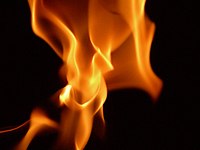
Photo from wikipedia
Abstract This research examines changes in the ion current and the release of carbon monoxide (CO) from surface-impinging coflow diffusion flames when subjecting those flames to high DC electric fields.… Click to show full abstract
Abstract This research examines changes in the ion current and the release of carbon monoxide (CO) from surface-impinging coflow diffusion flames when subjecting those flames to high DC electric fields. Carbon monoxide results from the incomplete oxidation of hydrocarbon fuels and, while CO can be desirable in some syngas processes, it is usually a dangerous emission from forest fires, gas heaters, stoves, or furnaces where the core reaction insufficiently oxidizes the fuel to carbon dioxide and water. Electrical aspects of flames, specifically, the production of chemi-ions in hydrocarbon flames and the convective flows driven by these ions, have been investigated in ranges of application, and this research examines the use of electric fields as one mechanism for governing combustion as flames are partially extinguished when impinging on nearby surfaces. We evaluate the ion current and study the flame behavior at saturation current in response to the impinging plate location. We also measure the changes in CO emission, as correlated with variations in flame structure observed using OH chemiluminescence and OH planar laser induced fluorescence (PLIF), as a function of burner-to-plate distance and electrical potential applied to the flame. Three major saturation current impact regions in plate distance is observed, and it uses chemiluminescence with PLIF to illuminate the relative locations of the peak heat release zone and the extended oxidative zone changing by external electric fields. The results show that CO release correlates strongly with changes in location and extent of high concentration regions of OH in the surface-impinging diffusion flames. The results also show that electric fields affect the CO emission but that the burner-to-plate distance has the dominant influence. The detailed findings indicate that a continuous monitor of ion current from the flame to the impinging surface can be an effective sensing index of flame behavior and CO emission.
Journal Title: Combustion and Flame
Year Published: 2019
Link to full text (if available)
Share on Social Media: Sign Up to like & get
recommendations!